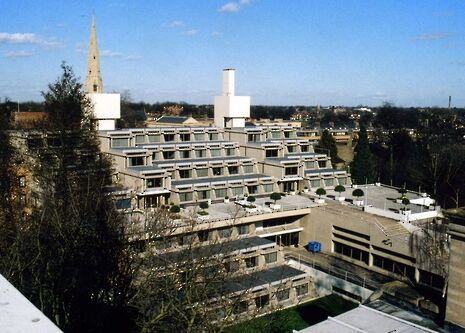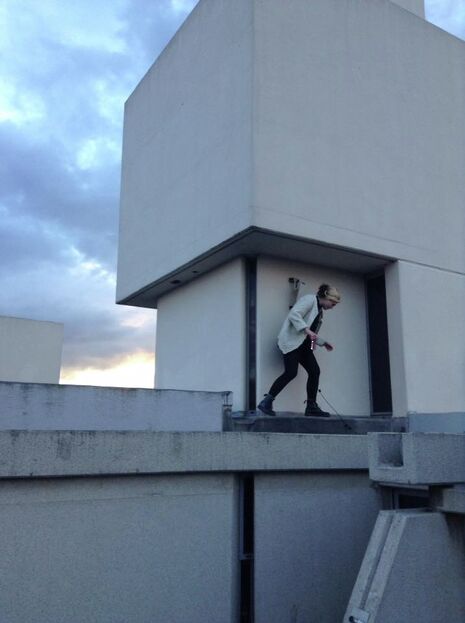Christ’s ugly back-end
Columnist Arianna Rabin peels back the veneer of rose-tinted college pride to examine Christ’s infamous ‘Typewriter’ building

Cambridge: A gorgeous city full of beautiful architecture, the product of a privileged history and full of awestruck gogglers. Its postcard image makes it the perfect city to visit as a tourist if you want to gain an impression of a British city other than London; the fact that its aesthetic is largely gained from one major period of building and patronage (Tudor) makes it doubly interesting from an art historical perspective as an example of that style.
But I’m not going to write about any of that pretty stuff here. Instead, let’s talk about an architectural monstrosity, built with the best of intentions but not exactly the best of results. Loyal Christ’s member that I am, I refer of course to the ‘Typewriter’ building at the back of Christ’s.
A perfect example of overzealous 1960s concrete obsession, the Typewriter was designed by Denys Lasdun in 1966. It’s completely at odds with the rest of the college, sticking out like a sore thumb in aerial photographs, and coming as an abrupt shock at the end of an otherwise delightful stroll through our 16th-century style college.
Allow me to describe it for you. Having entered through a magnificent Tudor gatehouse, complete with quintessentially Cambridge corner turrets (not to be found in any Oxford college!), we begin our journey through Christ’s. The 16th-century First Court is currently doubly impressive since the wisteria on the front of the Master’s Lodge is in full bloom. “How lovely!” you think, “This college is both pretty and unusual – look at that round first court lawn, I’m certain that’s the only one of its kind in Oxbridge!” Indeed, astute visitor, you would be correct in making this assumption.
“The boxes that give the Typewriter its nickname for their resemblance to said machine’s keys climb all the way to the two random towers sticking out the top.”
We continue into our Second Court, confronted on passing through a dark small passage, with the Fellows’ Building. “My Goodness!” you exclaim. “That building is clearly a fine example of early Classical architecture in Britain dating from the mid 17th century! This college is certainly ahead of the curve!“. Astute viewer, I’m beginning to wonder if you’re an art historian and/or member of this college, because once again you are correct.
Then we reach Third Court. Astute viewer, I’m going to abandon you at this point, because you’ve served your purpose as a rhetorical tool, and you’re going to get boring soon. Third Court in Christ’s doesn’t have any early modern buildings, but the 19th-century Stevenson building and matching 20th-century Blyth and Y buildings all try their best. They have the same pale stone fronting as the rest of college (indeed as the majority of Cambridge), and the Stevenson building, in typical Victorian neo-anything fashion, even has the Tudor coat of arms of our foundress on the front.
Now, pleasantly abuzz on the pretty (but not overstated), relatively uniform style of the previous courts, you enter New Court, your expectations high.
No! Alas! What is this? You are immediately confronted with a tall concrete staircase – so tall, in fact, that it is exhausting to look at (understandably, the poor students who live at the top of it rarely have visitors round for tea).

You walk further round into this oddly-shaped court; your eye wanders beyond the Darwin garden also in this court (beat that for a famous alum, Trinity), and climbs up, and up, and up… The boxes that give the Typewriter its nickname for their resemblance to said machine’s keys climb all the way to the two random towers sticking out of the top. Why are they there? What are they used for?
Truly these boxes are cell-like. The tiny rooms within are well-built for purpose: each has a tiny en-suite prone to flooding, and a little balcony one can use in the summer when not avoiding revision by writing articles for student newspapers. But that cannot make up for how ugly the building as a whole is. Granted, it’s stepped, which makes it a lot of fun to climb up, and perhaps it would have been prettier had they been able to grow gardens on each of its levels as was originally intended, but the poor thing is really letting the Christ’s team down in the which-is-the-prettiest-college race.
Despite the above, though, I do have to acknowledge my begrudging fondness for the Typewriter. It might well make the college ugly, but it also is one of the things that make Christ’s unique, and any reminder of the place I love to call home is a good thing in my book
 News / Clare Hall spent over £500k opposing busway 24 December 2025
News / Clare Hall spent over £500k opposing busway 24 December 2025 Comment / The ‘class’ of Cambridge24 December 2025
Comment / The ‘class’ of Cambridge24 December 2025 News / Caius mourns its tree-mendous loss23 December 2025
News / Caius mourns its tree-mendous loss23 December 2025 Comment / Yes, I’m brown – but I have more important things to say22 December 2025
Comment / Yes, I’m brown – but I have more important things to say22 December 2025 News / Girton JCR publishes open letter expressing solidarity with Palestine25 December 2025
News / Girton JCR publishes open letter expressing solidarity with Palestine25 December 2025









